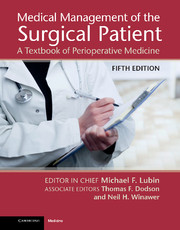Book contents
- Frontmatter
- Dedication
- Contents
- List of Contributors
- Preface
- Introduction
- Part 1 Perioperative Care of the Surgical Patient
- Part 2 Surgical Procedures and their Complications
- Section 17 General Surgery
- Section 18 Cardiothoracic Surgery
- Chapter 68 Coronary artery bypass procedures
- Chapter 69 Cardiac rhythm management
- Chapter 70 Aortic valve surgery
- Chapter 71 Mitral valve surgery
- Chapter 72 Ventricular assist devices and cardiac transplantation
- Chapter 73 Thoracic aortic disease
- Chapter 74 Pulmonary lobectomy
- Chapter 75 Pneumonectomy
- Chapter 76 Lung transplantation
- Chapter 77 Hiatal hernia repair
- Chapter 78 Esophagomyotomy
- Chapter 79 Esophagogastrectomy
- Chapter 80 Colon interposition for esophageal bypass
- Section 19 Vascular Surgery
- Section 20 Plastic and Reconstructive Surgery
- Section 21 Gynecologic Surgery
- Section 22 Neurologic Surgery
- Section 23 Ophthalmic Surgery
- Section 24 Orthopedic Surgery
- Section 25 Otolaryngologic Surgery
- Section 26 Urologic Surgery
- Index
- References
Chapter 75 - Pneumonectomy
from Section 18 - Cardiothoracic Surgery
Published online by Cambridge University Press: 05 September 2013
- Frontmatter
- Dedication
- Contents
- List of Contributors
- Preface
- Introduction
- Part 1 Perioperative Care of the Surgical Patient
- Part 2 Surgical Procedures and their Complications
- Section 17 General Surgery
- Section 18 Cardiothoracic Surgery
- Chapter 68 Coronary artery bypass procedures
- Chapter 69 Cardiac rhythm management
- Chapter 70 Aortic valve surgery
- Chapter 71 Mitral valve surgery
- Chapter 72 Ventricular assist devices and cardiac transplantation
- Chapter 73 Thoracic aortic disease
- Chapter 74 Pulmonary lobectomy
- Chapter 75 Pneumonectomy
- Chapter 76 Lung transplantation
- Chapter 77 Hiatal hernia repair
- Chapter 78 Esophagomyotomy
- Chapter 79 Esophagogastrectomy
- Chapter 80 Colon interposition for esophageal bypass
- Section 19 Vascular Surgery
- Section 20 Plastic and Reconstructive Surgery
- Section 21 Gynecologic Surgery
- Section 22 Neurologic Surgery
- Section 23 Ophthalmic Surgery
- Section 24 Orthopedic Surgery
- Section 25 Otolaryngologic Surgery
- Section 26 Urologic Surgery
- Index
- References
Summary
Currently, pneumonectomy is often performed for a bulky and centrally located carcinoma of the lung. Occasionally it is indicated for a destroyed lung secondary to chronic infectious disease such as tuberculosis, bronchiectasis, or fungal disease. In general, we favor preservation of pulmonary parenchyma and avoidance of pneumonectomy through the use of bronchial and/or vascular sleeve resections when possible.
All patients require a thorough evaluation to rule out metastatic disease as well as to ascertain their ability to tolerate the operation. Assessment of their cardiac status is carried out as per the American College of Cardiology/American Heart Association guidelines. Evaluation of the pulmonary status includes pulmonary function tests and, in marginal cases, quantitative ventilation/perfusion scans and cardiopulmonary exercise testing.
The operation is performed under general anesthesia administered via a double-lumen endotracheal tube. Although potentially feasible thoracoscopically for some tumors, our current approach for a pneumonectomy is through a posterolateral thoracotomy. A thoracic epidural is the cornerstone of pain management in patients undergoing a thoracotomy. The patient is placed in the lateral decubitus position with the operated side superior; the table is flexed maximally at the level of the patient’s hips; and contralateral single lung ventilation is started. Fiberoptic bronchoscopy allows confirmation of tube position and helps to rule out endobronchial disease. Continuous intraoperative monitoring of vital parameters has increased the safety of these procedures. A second-generation cephalosporin is administered preoperatively and continued for two postoperative doses. Almost all patients are extubated in the operating suite following surgery.
- Type
- Chapter
- Information
- Medical Management of the Surgical PatientA Textbook of Perioperative Medicine, pp. 588 - 590Publisher: Cambridge University PressPrint publication year: 2013

